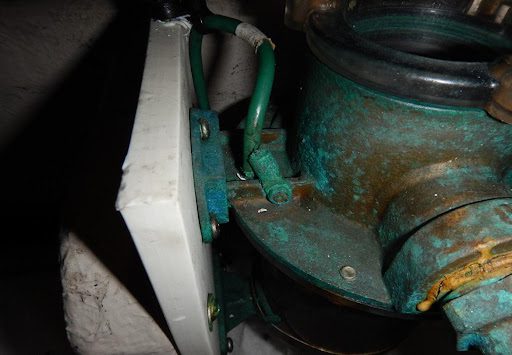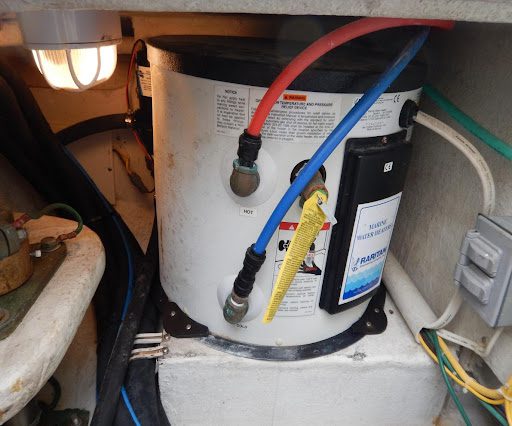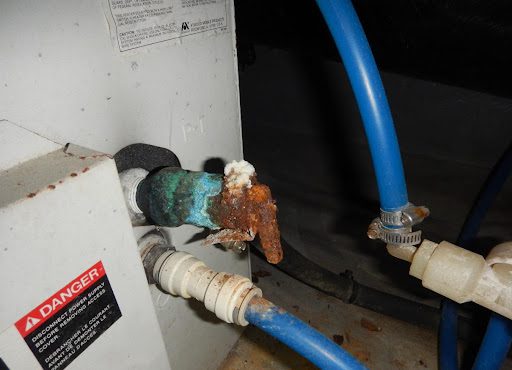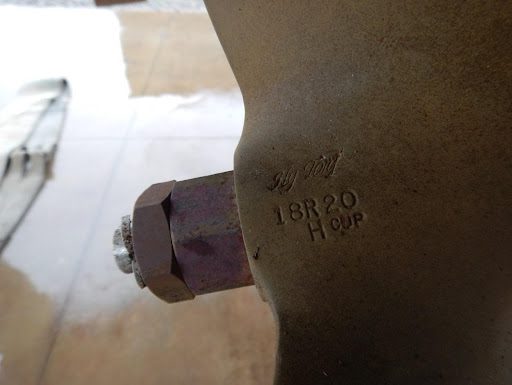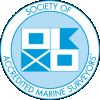Nautical Services, Inc.
Immediately servicing the Gulf Coast of Alabama, Mississippi, Louisiana and the Florida Panhandle, with regular travel to include inland and coastal States, Regions and Countries as requested.
Common Deficiencies Found at Survey
One of the most common and probably the number one deficiency found during the survey is; NO battery terminal lug boots, or improperly installed battery terminal lug boots, and improper or degraded terminal lug fasteners.
All it takes is a dropped wrench, part, or any other conductive component across the two terminals and at least it’s a melted wrench or component, and only that if you’re lucky.
Battery terminal lug connections should exhibit secured terminal lug boots that protect and cover both the threaded connection and large tapered post, and many batteries have both. Often and in many cases even with terminal lug boots installed, I see terminal lug boots that are adrift (ill-fitted or loose) to one side or the other, only covering either the threaded connection or tapered terminal post, leaving one exposed.
The alternative of course to COMPLETE terminal lug boots are: batteries in acid proof protective dedicated boxes with full protective covers that are secured.
With that said, it stands to reason that when batteries exhibit unprotected terminal lug connections, they usually exhibit degraded connections: meaning corroded, frayed, rusted, loose and/or in generally poor condition. Poor, loose, rusted and/or corroded battery connections are degenerative exponentially and another possible problem waiting to happen, especially with gasoline operated systems below decks.
Provide proper battery boxes for your batteries, if this is not an option, provide COMPLETE terminal lug boot protection on at least the positive lug posts, and maintain secure connections with lock nuts or nuts with lock washers, NOT utilizing wing nuts. Utilize corrosion resistant or dielectric grease on connections and provide adequate securing, whether it be acid resistant spill proof boxes or just straps.

Corroded and Frayed Connections, No Terminal Lug Protection and Unsecured

Properly Set-up Battery Bank. Nicely Done!




*The next most common deficiencies found are degraded below the waterline hoses and stainless steel clamps.
Almost every survey produces deficiencies regarding below the waterline hoses and clamps. Below the water line hoses & clamps typically start from a seacock, then usually to a strainer, and then to a pump or component that’s utilizing raw water in some form or fashion.
Most of the time when there are degraded hoses, there are also rusted, degraded stainless steel clamps to component connections, and then inevitably an inoperable seacock.
Think about that for a minute, an open hole in the bottom of the vessel with hoses ready to fail, a single clamp that is rusted to the point of falling off the hose connection, and a seacock that will not operate and/or is froze in the open position…..”Where are those wooden dowel plugs again?”
*The most commonly overlooked raw water circuit is the (AC) Air Conditioning circuit. I’m assuming that’s the case because it’s probably the most used system on the vessel and unless it quits blowing cold air, it is assumed to be in good operating order.
Therefore, I suspect the mind-set is, if it’s working, it must be in good order. Inspections or maintenance is generally overlooked until it quits working, or the vessel starts taking on water because a hose or clamp has failed.
How many people do you suspect open the hood on an automobile and inspect hoses and clamps on a regular basis? Exactly, only automobiles don’t sink.
*The next common below the waterline neglected plumbing circuit is the black water system (waste) O/B discharge seacock, hoses and clamps. This actually might be number one (no pun intended) but another overlooked and disregarded area of the vessels below the waterline systems. If you don’t use it or it’s operating, it has to be O.K right. Wrong! Most folks never use the black water overboard discharge seacock because they likely never discharge overboard.
It’s the usual run to the island to have a few cocktails, or dine at the local on the water eatery, and that’s that. Can’t discharge overboard inshore anyway, right? So the (O/B) overboard black water system (hoses & clamps) never get inspected or seacock operated. When the waste system black water tank is full, it likely gets pumped-out at the (waste) deck fitting and dock pump-out station.
Again, seacocks that don’t get exercised regularly will freeze or get stuck in whatever position their left in. In the case of the black water O/B overboard discharge seacock (waste), it should be less of a problem since it should be in the off or closed position at all times.
Other seacocks such as: AC, engine raw water, generator raw water and so on, if any one of these seacocks freeze or get stuck in their normal position and a hose breaks, it could potentially sink the vessel. It will certainly sink if you’re not there, and probably if you are, because you can’t close or shut-off the seacock in an open froze position.
Other components of the raw water intake circuits are discharges: “What comes in must go out” Therefore, there are other components which again consist of hoses and clamps that are overlooked or disregarded.
Example: Engine raw water intake and exhaust discharge, Generator raw water intake and exhaust discharge and (AC) Air conditioning just to name a few.

Generator Exhaust Discharge Hose and Clamps Degraded

Engine Exhaust Discharge Flexible Connector and Clamps Degraded

Engine Exhaust Discharge Flexible Connector and Clamps Degraded

MAIN ENGINE EXHAUST DISCHARGE FLEXIBLE HOSE CONNECTOR AND CLAMPS DESTRUCTED.

Air Conditioning Raw Water Intake Seacock W/ No on/off Handle and Degraded Hose
(Excellent Submersion Source Waiting to Happen)
Below are just a few below the waterline systems that might be utilized on your vessel, although there are many below the waterline thru-hull connections and systems utilized depending on the vessels size and type.
Inspect and service your vessels particular systems on a regular basis. Make it a point to create a hull diagram of seacocks, thru-hulls and discharges to inspect every month or so. It is also recommended to exercise (open/close) all seacocks on a regular basis. This will also be of value if you forget the whereabouts of a particular seacock and need to shut-off in an emergency.
Typical below the waterline systems:
- Air Conditioning
- Main Engine’s
- Generator
- Raw water wash-down
- Live-well
- Blackwater (waste)
- Water maker
- Refrigeration
- Hydraulic cooling pumps





*The next most popular deficiency found is the fixed fire suppression system in the engine room or generator space. Most, if not all, are not up to date on certifications or inspections. The inspection/re-certification costs vary by type, size and complexity of the system.
On most fixed fire suppression systems, it is relatively inexpensive and can be recertified by a local fire suppression expert, who will re-certify to the system or manufactures recommended specifications.
For the cost of re-certification, and for the life of me, I can’t understand why this is a routinely noted safety deficiency.
Call your local fire suppression expert and ask what it costs to recertify your system, it’s well worth the little bit of money for re-certification and certainly worth the peace of mind.
In addition, you may find unknowingly that the system was in an inoperable condition, or that it may have to be replaced. Better to find out then, as opposed to when you need it!

No Current Certifications/inspection
*While we’re on the safety related deficiencies, another very common deficiency found is C.O detectors (carbon monoxide detectors) very rarely (although getting better) do any or all the C.O detectors function, and half the time their un-plugged under their cover if the vessel has them at all. As per ABYC, vessels with accommodation spaces should have an operable C.O detector.
The million-dollar question is; “why do I need a C.O detector if I have a diesel engine boat”. Well, good question… Diesel engine emissions inherently do not put out enough PPM’s (parts per million Carbon Monoxide) to really hurt you, however, remember the trip to the island for cocktails? Well, you had a few more than usual this time and you wisely decide to stay overnight. You anchor up, and soon another vessel anchors up next to you, he/she has gasoline main engines and generator. He/she runs the gasoline generator all night while you’re enjoying fresh air from the V-berth porthole or ventilation and egress hatch forward. Exhaust fumes from you’re new neighbors gasoline generator finds its way to your fresh air porthole. Well! it doesn’t make a difference whether you are in a dead sleep from having a few more than normal cocktails or awake, then end result is probably “Game over” for you, C.O poisoning! You either don’t wake up! Or you pass out.
Remember! Carbon Monoxide is tasteless and odorless and you could very well be awake and still be overcome and/or asphyxiated due to Carbon Monoxide.
This is just one example of a potential scenario that could find itself upon you, so use due diligence and maintain or install your C.O detectors as recommended. Don’t unplug them because they chirp every few minutes, that means they are degraded or inoperable for the most part so replace them as needed.

Typical Make and Style Found. Unplugged Underneath the Cover and/or Inoperable

Typical Model and Style Found

Another Type Common Co Detector Installed
With CO detectors there should also be smoke detectors, or at least a combo unit CO/Smoke combination.
Again, this is another very frequent safety finding. It is highly recommended that any vessel with an accommodation space, have an operable smoke detector recommended per ABYC.
*Bilge pumps and float switches: not a routine finding, but on occasion I find bilge pumps and float switches that are inoperable, or both that are unsecure and/or adrift.
At the same time and usually in the same area are High water alarm float switches. These to I find on occasion adrift, on their side or inoperable.
On many surveys I find float switches to bilge pumps, and bilge pumps that are lying on their side, neither will work or work properly if its 90 degrees opposed to its intended mounting position or lying on its side.
A bilge pump will still operate regardless, but it will not operate correctly or automatically if either is lying on its side, restricted from movement by debris, wiring or something else.
Make it a habit to routinely check pumps manually, and float switch operation of your vessels de-watering devices. Be sure both are secure, float switches are clear to move up/down and both are mounted or installed in their correct orientation.
Additionally, be sure to keep bilges clean from oil, fishing line, tools, zip ties and any other foreign matter that might restrict the float switch operation or clog the bilge pump.

Bilge Pump Completly Adrift. Oddly, It Was the One That Operated, Although I Don’t Think Its Going to Discharge or Dewater Much. The Other One Tested Inoperable

Float Switch Restricted From Operating by Its Own Wiring, Debris and Oil Immulsion in the Bilge
Other Typical Deficiencies Found on a Regular Basis
- Wire nuts utilized on component connections
- No safety wire on anchor rode shackle pins
- Broken or corroded bond wires to bonded components
- Water heater OPV (over pressure release valves) not plumbed overboard or destructed
- Propeller nuts reversed.



